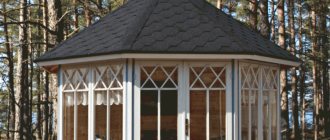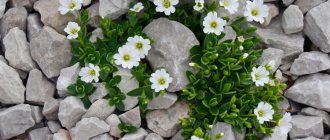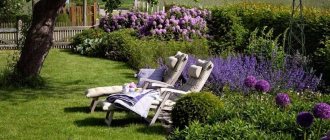Where does the plant look best?
In the wild, astilbe can be found in dense deciduous forests and along the banks of reservoirs. It perfectly tolerates moderately moist soil and shaded areas, which makes it possible to plant this plant near an artificial lake and in gardens with tall trees and shrubs.
This amazing plant, in addition to its luxurious forms, also has several colors, which allows you to decorate almost any flower bed or lawn in various styles and directions. The range of astilbe shades is small:
- white,
- soft peach,
- pink,
- lilac,
- deep scarlet.
But this does not bother landscape designers, who invariably use the plant in their projects.
Here are some planting options featuring this flower, as well as combinations of astilbe with other plants.
Astilbe care
The growth rate and splendor of astilbe depends on the correct choice of site for planting, on the level of heat and moisture. It is frost-resistant, almost not afraid of pests and diseases, and pleases with abundant flowering.
Temperature
Astilbe tolerates conditions of temperate latitudes well, but active vegetation begins only when the temperature remains stably above 10 degrees. In winter, the entire above-ground part dies off: this is completely normal, in the spring the flower will grow again.
Lighting
Astilbe does not need an abundance of light and continues to bloom well and thickly even in the shade. Its ideal conditions are sparse shade, but light-colored varieties do well in full sun. Then their flowering is almost twice as intense, but also proportionally shorter.
Watering
Watering is the only difficult moment in caring for astilbe, because it is a very moisture-loving flower that prefers the monsoon climate. It absolutely cannot cope with prolonged drought, especially in combination with poor soil and heat. Therefore, in the sun, seedlings need to be watered twice a day, and in comfortable shade, weekly watering is sufficient.
At the same time, astilbe does not tolerate excess moisture well, including high groundwater levels. Because of this, the roots damp out and rot, so do not forget about high-quality reliable drainage or choose higher places. Be sure to mulch the soil: this reduces overheating, guarantees breathability, looseness, retains moisture, but prevents rotting.
Fertilizers and fertilizing
The first portion of fertilizer is applied during planting, but for the development and growth of astilbe, regular feeding is needed. Especially if you have been growing a perennial flower in one place for years. For example, nitrogen fertilizers promote leaf renewal after winter, phosphorus fertilizers promote lush flowering, and potassium fertilizers promote the formation of seeds.
Trimming
The decorative effect of thick and rapidly growing astilbe directly depends on regular pruning. And be sure to remove all faded inflorescences before the formation of seed pods. Especially if you use astilbe for decoration and landscape design.
Columnar apple tree: varieties, care and cultivation (photo)
Astilbe in roadside flower beds and borders
Tall fluffy astilbe, planted along garden paths, looks impressive and original both in the company of other flowers and shrubs, and among plantings consisting exclusively of its different subspecies and varieties.
Astilbe in mixborders
The spreading panicles of astilbe effectively complement flower and shrub crops in mixed compositions.
A few more examples of the use of astilbe of different varieties and hybrids in landscape design.
Recent Entries
Lilac perennials that are beautiful, compact and do not crowd out other plants Why when buying seedlings you should not take the sellers’ word for it and how to determine the age of the plant using 3 signs Tomato seedlings have turned purple or whitish: why the color has changed and how to save the plants
As mentioned earlier, astilbe loves moist soil and therefore can be planted near small bodies of water.
When designing a landscape, it is necessary to take into account the compatibility of plants. Astilbes are especially expressive in tandem with hosta, barberry, spirea, fern and juniper.
Astilbe: what to plant next to
Before deciding what to plant astilbe in the flowerbed with, it’s worth understanding its features and studying the description. This plant is picturesque, bright, and has numerous inflorescences. They can decorate a lawn, garden or flower garden. It is grown in Asia, Japan, China, and Mongolia. It is also called "false spirea". In the selection of neighboring plants, it also matters whether astilbe is a shrub or a flower.
What does astilbe look like?
Important! Astilbe is loved by many gardeners, so about thirty varieties and species of this plant have been bred.
What do the leaves look like?
Astilbe leaves have compound, double-pinnate leaves. Some leaves have a heart-shaped base. They are shiny on top and matte underneath. They look very unusual in bright sunshine. The foliage can also be deep olive, bronze and burgundy.
What does an astilbe flower look like?
The plant belongs to the Saxifraga family. The height, depending on the variety, can be from 20 to 200 cm. Astilbe blooms from June to September. The flowers exude a delicate aroma that is reminiscent of bird cherry. The color of the petals can be white, pink, burgundy, red and lilac.
There are several forms of inflorescences:
- Drooping. The inflorescences are on a long and narrow stem. They descend to the ground, which looks especially elegant and sophisticated.
- In the form of a pyramid. The side parts with flowers have a perpendicular divergence to the central axis. These parts become thinner and shorter. The inflorescences narrow from the base to the crown.
- Paniculata. Here the lateral branches also diverge perpendicular to the axial one, but they also branch strongly
- Rhombic. Branches with flowers grow at right angles and form something like a diamond.
Tall varieties
Tall varieties of astilbe:
- Amethyst: the bush can grow up to 1 meter in height; the flowers are large and blue-violet in color;
- Arendsa: grows up to 160 cm; large pink flowers;
- Pomegranate: grows up to two meters; the flowers are blood red;
- Diamond: grows up to 1.5 meters in height; the flowers are large and white;
- Ostrich feather: grows up to 80 cm; the flowers have a lavender hue;
- Thunder and lightning: height can reach 80 cm; small ruby-colored flowers;
- Lavender: grows up to 1 meter; The flowers are small and lavender in color.
A successful combination is obtained with the following plants: lilies, daffodils, crocuses, tulips, hosts, juniper, ferns, conifers.
Important! In the first year after the plant was planted, its leaves do not look very beautiful and luxurious. In this regard, snowdrops, hazel grouse, and crocuses are planted nearby. This is done to fill empty space.
Low growing varieties
Low-growing varieties of astilbe include:
- Visions in ed: height up to 30 cm. Flowers are small, bright purple. They have a strong aroma.
- Gloria: height 50 cm. Lush inflorescences in the shape of a diamond. The flowers themselves are small and white.
- Europe: height up to 50 cm Flowers are pale pink and odorless.
- Montgomery: height up to 70 cm. Flowers pink and large.
- Purple Rhine: height up to 50 cm. Flowers are small purple-pink.
What to plant next to low-growing astilbe depends on the time of year. For example, in spring it looks good with rhododendrons and Iberis. The best combination of this plant is next to daylilies, hostas and bergenia. A good option is to plant it next to a rose. However, in this case, a certain distance must be maintained.
Astilbe bushes near the trees
Astilbes look advantageous in the shade of the crown of large deciduous and coniferous trees, against the background of large and medium-sized shrubs.
Astilbes and hostas
Tall, slender astilbes go well with hostas with wide, bright leaves. These plants complement each other very favorably.
Tandem with juniper
Against the background of coniferous juniper, astilbe looks especially elegant, attracting the eye and being a bright accent in the composition.
Examples of design of naturgardens and park areas.
Astilbe is one of those flowering perennials that does not require complex care and, most importantly, can survive cold winters in open ground. No wonder this beautiful plant is deservedly popular among gardeners and landscape designers.
- Author: Ilona Lukina
Rate this article:
- 5
- 4
- 3
- 2
- 1
(33 votes, average: 4.2 out of 5)
Share with your friends!
How to grow and care
The perennial is unpretentious; it does not require special skills when growing.
In what conditions should it be kept?
Conditions in which many flowers simply cannot survive are excellent for astilbe. She prefers moist, shady, low-lying areas, preferably near a pond or close to groundwater.
Flowers are planted at the end of May on previously prepared soil .
Before planting, dig up and loosen the area. Remove all weeds.
Watering
The plant requires abundant and frequent watering.
Important! During the formation of inflorescences and on very hot days, the volume of watering should be increased.
Pay attention to another feature of the perennial - its root grows upward over time . This means that it is necessary to regularly rake the soil to the exposed rhizome, otherwise the astilbe will not be able to fully feed.
Feeding
On average, a bush can grow in one place for up to 7 years without losing its properties, but with regular high-quality feeding, its lifespan can reach 20 years.
Astilbe is fed three times during the growing season:
- in the spring, nitrogen complexes are introduced;
- in mid-summer they give potassium fertilizers;
- At the end of flowering, it is the turn of phosphorus.
Wintering
After the astilbe has bloomed, do not immediately remove the inflorescences . They dry out, but do not lose their decorative qualities and can serve as a garden decoration until the coldest weather.
Preparation for cold weather involves the complete removal of the above-ground part of the plant. The root is sprinkled with a generous layer of mulch and left in this form for the winter.
Spring care
When the snow has melted, you can slightly rake away the layer of mulch and remove the shoots remaining from the fall, if they have not been cut off.
Approximately once every 3 years, the procedure of dividing the bush is carried out . This will help keep flowering high and rejuvenate the plant.
Acceleration of flowering
To stimulate earlier flowering of astilbe, the root needs to be dug up in the fall . It is placed in small diameter pots (no more than 20 cm) and stored in moist peat at a temperature of about 0...-1.5 °C.
In February, they begin to artificially stimulate vegetation by raising the temperature to 10 °C. It is good at this time to transfer the pot of astilbe to the greenhouse.
When the root sends out the first arrows, the temperature is raised to 15 ° C, and the flowers themselves are slightly shaded.
Important! There is no need to fertilize the flowers during this period; they only require watering.
Plants stimulated in this way begin to flower as early as May, while natural flowering is possible only from the end of June.
Read about other perennials for landscape design:
Evening primrose or primrose: a little-known perennial
Rosa Santana - a climbing garden decoration
Arabis - delicate snowdrifts of four-petaled flowers
Removing inflorescences
This procedure will increase the flowering time of astilbe, so dried inflorescences are often removed from the bush.











